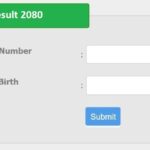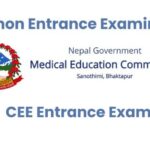PU Engineering Chemistry Syllabus 2080 – Candidates will be able to check the PU Engineering Entrance 2080 Chemistry syllabus online. Pokhara University will release the complete syllabus of PU Engineering Entrance 2080 Chemistry on the website soe.pu.edu.np. Candidates will be able to check the PU Engineering Entrance Chemistry syllabus 2080 pdf on this page soon after the official release. The Chemistry syllabus for PU Engineering Entrance 2080 will comprise important topics for the preparation of the exam. Candidates can check the PU Engineering Entrance Chemistry syllabus with a weightage pdf to know which topics have a high weightage of questions. However, candidates can refer to the PU Engineering Entrance previous year’s question paper to know the high-weightage topics and check the level of preparation. Pokhara University will conduct the PU Engineering Entrance exam in online mode.
PU Engineering Chemistry Syllabus 2080
Chemistry is an important subject to cover while preparing for PU Engineering Entrance. The problems in the PU Entrance Exam Chemistry section are a bit tricky to solve as it requires a student to use both theoretical and practical knowledge. Students must comprehend the concepts on priority and then practice PU Engineering questions based on their theoretical and practical aspects. For creating an effective preparation study plan for PU Engineering Entrance, students should check the detailed syllabus of Chemistry given below, so they do not miss any significant concept or chapter.
| Subjects | Questions |
|---|---|
| Physics | 25*1=25 |
| Chemistry | 15*1=15 |
| Mathematics | 40*1=40 |
| English | 20*1=20 |

PU Engineering Syllabus Engineering Chemistry
PU Engineering Entrance 2080 syllabus will be available online for all subjects. Candidates can check the syllabus of PU Engineering Entrance 2080 to know the important topics for exam preparations. Aspirants have to prepare the topics based on the PU Engineering Entrance syllabus and weightage. Candidates can check the PU Engineering Entrance 2080 syllabus with weightage pdf to know the important topics for the preparations. Move over the high-priority topics of the PU 2080 Chemistry syllabus prior to others. Candidates should also check the PU Engineering Entrance chemistry important topics. Check the previous year’s PU Chemistry syllabus below.
| Syllabus for Chemistry |
|---|
| Language of Chemistry & Physical Chemistry |
| Symbol, formulate valency and chemical questions, |
| Problems based on chemical equations (relation with weight and weight, and weight and volume); |
| Atomic Structure |
| Study of Cathode rays, and discovery of electrons, |
| Rutheford’s X-ray scattering experiment and discovery of nucleus. |
| Rutherford model of atom, Bohr model of atom, |
| Elementary concept of quantum numbers, Electron configuration of the elements. |
| Theory to Valency |
| Octet rule, Electrovalency, covalency and coordinate valency, |
| General characteristics of ionic and covalent compounds; |
| Oxidation and Reduction |
| Classical definitions, Electronic interpretations of oxidation and reduction, |
| Balancing of redox equations by oxidation number method; |
| Periodic Classification of Elements |
| Mendeleev’s periodic law, anomalies of Mendeleev’s periodic table, |
| Modern periodic Law, Periodic Properties viz. ionization potential, |
| electronegativity and atomic radii, and their variation in the periodic table; |
| Equivalent Weight and Atomic Weight |
| Concept of equivalent weight, and its determination by hydrogen displacement method and oxide method |
| Concept of atomic weight, equivalent weight and valency, |
| determination of atomic weight using Dulong and Petit’s rule; |
| Molecular Weight and Mole |
| Avogardo’s hypothesis and its deductions, Avogadro number and concept of mole |
| Determination of molecular weight by Victor Meyer’s method; |
| Electro-Chemistry |
| Electrolytes and non-electrolytes, strong electrolytes and weak electrolytes, |
| Faraday’s laws of electrolysis, |
| Avogardo’s hypothesis and its deductions, Avogadro’s number and concept of mole |
| Theories of Acids and Bases |
| Arrhenius theory, Bronsted and Lowry theory, Lewis theory; |
| Volumetric Analysis |
| Equivalent weights of acids, base and salts, Principles of acidimetry and alkalimetry, pH and pH scale; |
| Non-Metals |
| Water: Hard water and soft water, Nitrogen cycle, PManufacture of ammonia and nitric acid; |
| Causes and removal of hardness of water; Nitrogen and its Compounds: |
| Preparation of ammonia and nitric acid in the lab, and their properties, |
| Allotropy of sulphur, Preparation of hydrogen sulphide, |
| Sulphur dioxide in the lab, and their properties, |
| Manufacture of sulphuric acid by contact process; |
| Halogens and Their Compound |
| Position of halogens in the periodic table, |
| Compounds of Metals: General methods of preparation and properties of oxides, hydroxides, chlorides, nitrates, sulfates and carbonates of metals; |
| Metals |
| Zinc: Extraction of zinc from zinc blend, Galvanization; Iron: Extraction of cast iron from hematite, Cast iron, steel, and wrought iron, Types of steel, Manufacture of steel; |
| Sodium: Extraction of Sodium (Down’s process), Manufacture of caustic soda sodium carbonate; Copper: Extraction of copper from copper pyrite, Manufacture of Blue vitriol; |
| Zinc: Extraction of zinc from zinc blend, Galvanization; Iron: Extraction of cast iron from hematite, Cast iron, steel and wrought iron, Types of steel, Manufacture of steel; |
| Organic Chemistry |
| Sources and Purification of organic Compounds: Characteristics of organic compounds, Sources of organic compounds, Purification of organic compounds; |
| Classification and nomenclature of organic Compounds: Functional group, homologous series, and isomerism (structural only), Classification of organic compounds, Common names, and I.U.P.A.C. naming system; |
| Saturated and unsaturated Hydrocarbons & Aromatic compound |
| Preparation and properties of methane, Preparation and properties of ethylene and acetylene, Alkyl Halides: Preparation and properties of ethyl iodide; |
| Aromatic Compounds: Structure of benzene, Preparation of benzene in the laboratory, Properties of benzene; |
PU Engineering Entrance 2079: Tips and Tricks for Attempting the Chemistry Paper
Success in competitive exams like PU Engineering Entrance requires not just thorough preparation but also adept paper-handling skills. Here are succinct yet powerful strategies for approaching the PU Engineering Entrance paper effectively:
Strategic Order: Begin with Physics, then Mathematics, and end with Chemistry. This gradual complexity alignment lets you secure marks early on.
Efficient Elimination: For Math, apply substitution and elimination. Save time, ensure accuracy.
Past Paper Insight: Solve previous years’ papers, analyzing strengths and areas for improvement. Prioritize accordingly.
Precision Pays: Focus on your strengths to conserve time and energy. Quality over quantity.
Strategic Selection: Opt for confident attempts, avoid excessive risk. Skip very challenging questions to concentrate on manageable ones.
Time Savvy: Allocate 15 minutes for post-exam revision. Rectify errors for a final boost.
Frequently Asked Questions (FAQs) on PU Engineering Entrance Chemistry Exam
Have the authorities released the official syllabus of Chemistry for PU Engineering Entrance 2080?
Yes, Pokhara University will release the PU Engineering Entrance 2080 syllabus on its official website
Which are the best book for PU Engineering Entrance 2080 chemistry?
Class 11 and class 12 are the best books to study Chemistry for PU Engineering Entrance 2080.
Will the PU Engineering Entrance 2080 Chemistry syllabus have questions from Class XI also?
Yes, the PU Engineering Entrance Chemistry syllabus contains topics from class 11th and 12th.
Are there any changes in the PU Engineering Entrance Chemistry 2080 syllabus?
The PU Engineering Entrance 2080 Chemistry syllabus has been released. Once available, candidates can download the subject-wise syllabus PDF from this article.





